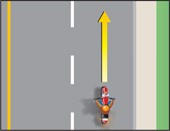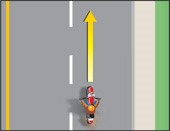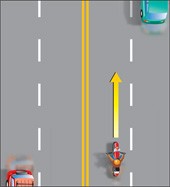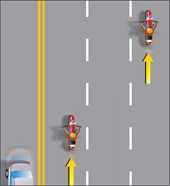Positioning
Lane position
On a motorcycle or moped, you do not have the protection of a vehicle around you, so you have to make your own protection. To do this, you need to position your vehicle in the best possible spot on the road.
Depending on traffic and road conditions, the best position in the lane is usually a little to the left or right of the centre of the lane, in the track where the tires of a four-wheeled vehicle would travel. This spot is referred to as the left or right “tire track.” It is considered the best position for keeping a safe distance from other vehicles, for seeing and being seen, and for the smoothest road surface with the best traction. It is also called the “blocking position” because it blocks or discourages other drivers from trying to squeeze past you in the same lane.
Limited-speed motorcycles and mopeds
If your vehicle is capable of maintaining the posted speed limit of the road, you should use the proper tire track position. However, if your vehicle cannot maintain the posted speed limit, you may drive as close as safely possible to the right-hand curb or edge of the roadway. You must allow faster vehicles to pass you when it is safe and practical to do so. Where it is dangerous to drive too close to the curb or edge of the roadway due to grates or other hazards, or if the lane is too narrow to safely allow vehicles to pass you, you may use a blocking position in the lane so that no one can pass you.
Wrong position
The centre of the lane is not a good driving position because it is coated with oil from other vehicles and gets slippery when wet.

Curb lane
In the right lane of a two-lane road, you should be slightly to the left of the centre of the lane in the left tire track. This position provides good visibility and blocks other vehicles from pulling up beside you in the lane.

Passing lane
In the passing lane, you should be slightly to the right of the centre of the lane in the right tire track. This provides good visibility and blocks other vehicles from driving beside you in the lane.

Centre lane
On a freeway with three or more lanes, do not drive in the centre lane, if possible, because you do not have a blocking position.

Right turn — same-size lane
Approaching an intersection where the curb lane remains the same size, stay in the normal blocking position (left tire track). Some motorcycle drivers angle their motorcycles across the lane (45 degrees) to create a larger blocking position and to make themselves more visible to drivers behind them. Make your turn and move to the correct lane position after completing the turn.

Right turn — wider lane
Making a right turn is more complicated when approaching an intersection where the lane opens up. Because the stop line is farther out, you must move over from your normal blocking position (left tire track) to prevent another vehicle from coming up on the inside on the wider part of the road. Check over your shoulder and move over to the right tire track. Again, you may want to angle your vehicle across the lane to make yourself more visible and to keep other vehicles from pulling up beside you. Make your right turn and then make another shoulder check if necessary and move back to the proper blocking position (left tire track).

Left turn — from curb lane to curb lane
From the curb lane, make your turn, keeping your blocking position (left tire track) throughout the turn.

Left turn — from passing lane to passing lane
From the passing lane, make your turn, keeping your blocking position (right tire track) throughout the turn.

Changing lanes
Weaving in and out of heavy traffic is dangerous and is usually done by inexperienced or aggressive drivers. When you are travelling in heavy traffic, stay in the same lane as much as possible.
When you have to change lanes, check your mirrors to make sure there is no traffic overtaking you. If it is safe, signal, check your mirror again and then turn your head and check over your shoulder before changing lanes. Checking over your shoulder is the only sure way to see a vehicle behind you in the next lane. This is particularly important, because there is little chance a driver in the next lane can react quickly enough to avoid you once you have started to change lanes.
On a road with several lanes, check the far lanes as well as the one next to you. Another driver may be headed for the same space you are.
Lane sharing
Unless your vehicle cannot maintain the posted speed limit of the road and you are driving close to right curb or edge of the roadway, you should not share your lane with other vehicles. The best way to avoid lane sharing is to keep your blocking position, especially in situations where other drivers might be tempted to squeeze by you. This is most likely to happen in the following situations:
- Heavy bumper-to-bumper traffic
- When you are preparing to turn at an intersection
- When you are entering an exit lane or leaving the freeway
- When another driver wants to pass you
Lane splitting
In heavy traffic, some motorcycle and moped drivers try “lane splitting” by driving on the line between lanes of traffic. This is extremely dangerous. Do not do it. It puts you too close to other vehicles. Other drivers do not expect a vehicle to be in that space. Just a small movement, such as a vehicle starting to change lanes or a door opening, can cause a collision because there is no place else for you to go.
Passing on the shoulder
The only time you may drive on the right shoulder of the road is to pass a vehicle turning left, and then only if the shoulder is paved. You may not pass on the left shoulder, whether it is paved or not.
Summary
By the end of this section, you should know:
- The concept of using tire track/block position to drive in the safest possible position on the road
- Various scenarios when you would use different lane positioning
- Which lane position you should use in various turns
- The danger of lane sharing, lane splitting and passing on the shoulder